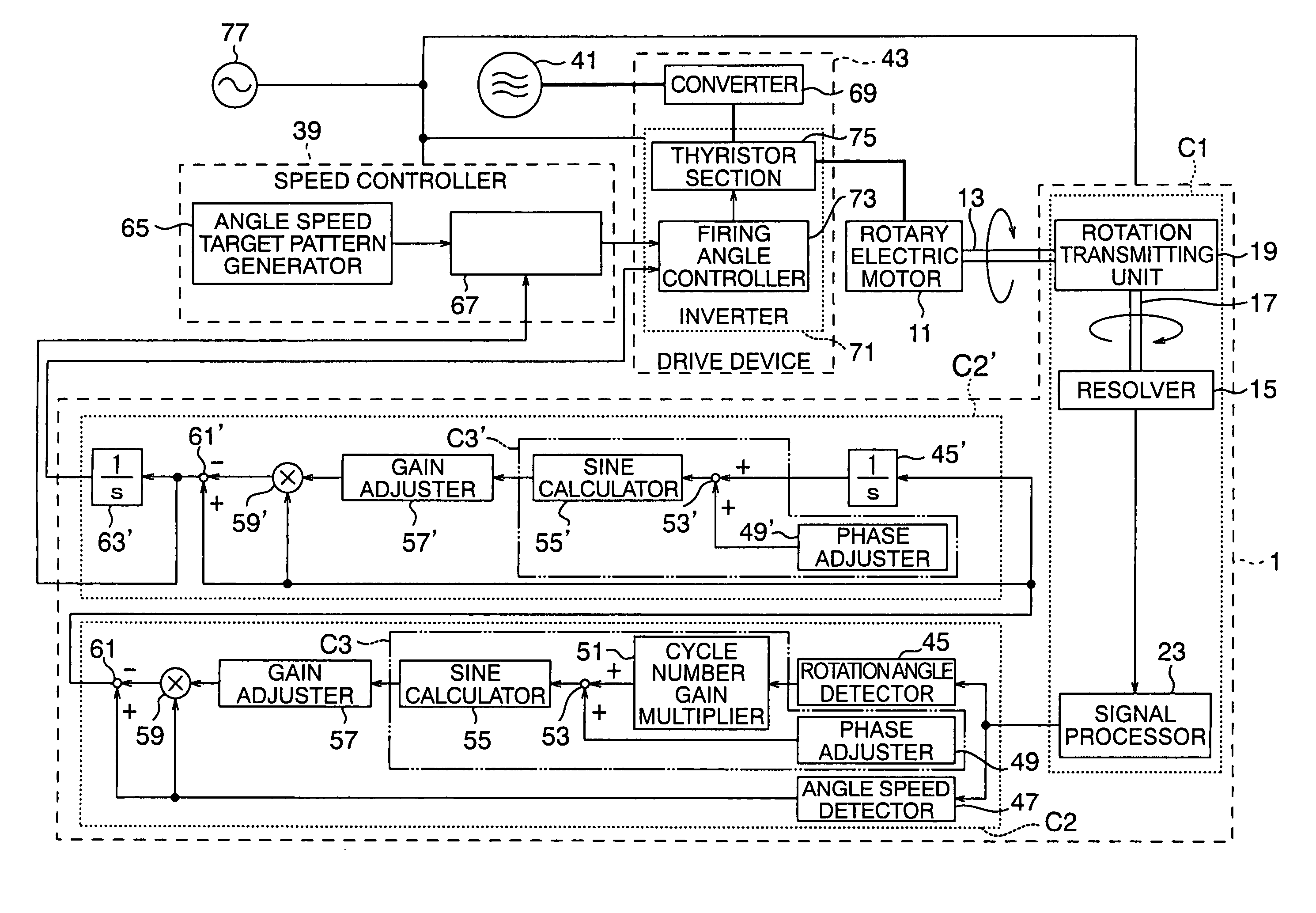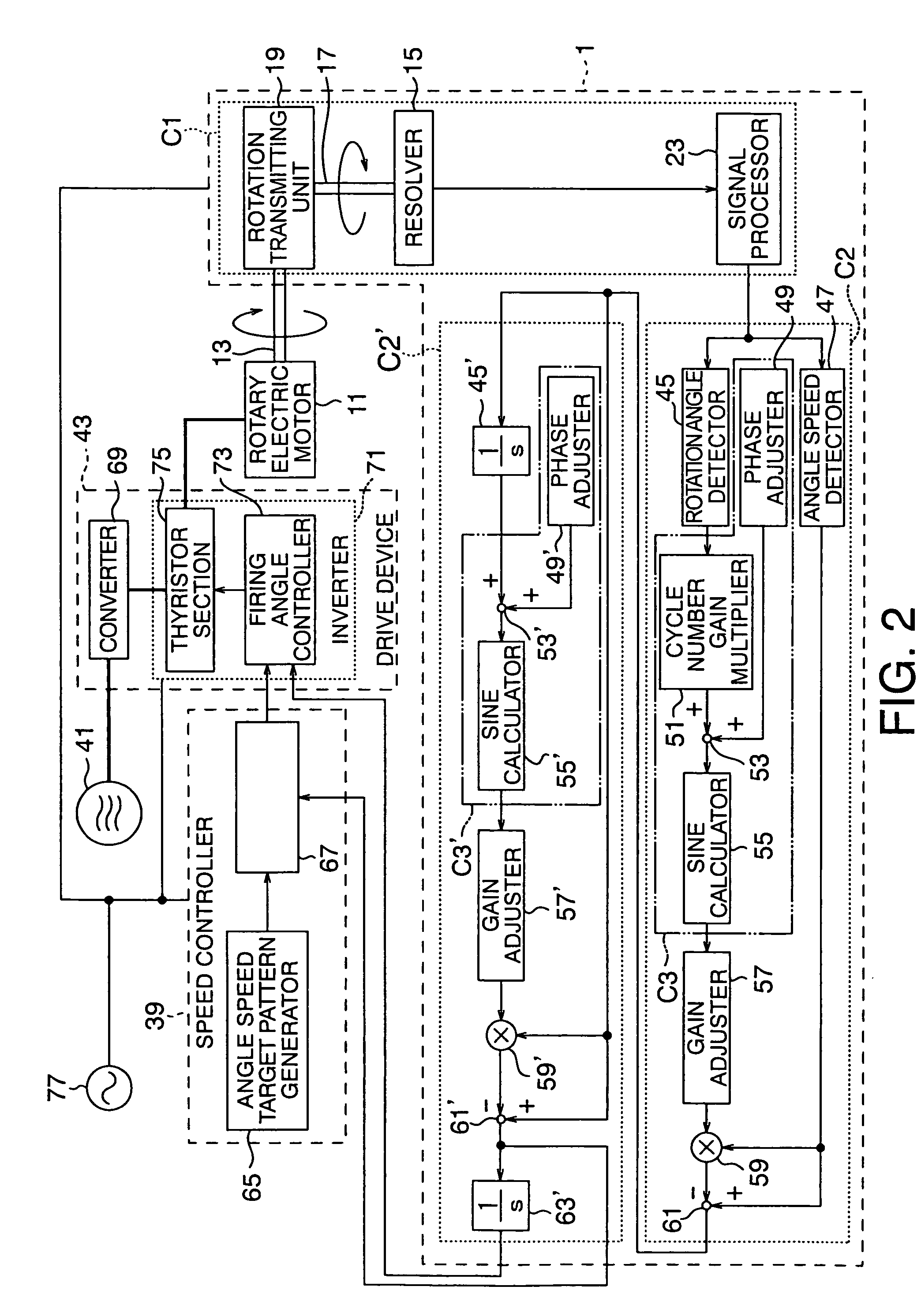Rotational speed detector with ripple compensation
- Summary
- Abstract
- Description
- Claims
- Application Information
AI Technical Summary
Benefits of technology
Problems solved by technology
Method used
Image
Examples
embodiment 1
[0051]A first embodiment of this invention will be explained with reference to FIGS. 1 to 7.
[0052]In FIGS. 1 and 2, reference code 1 represents the overall rotary detector in a first embodiment. The rotary detector 1 comprises a rotary detector unit C1, and rotary calculator units C2 and C2′.
[0053]The rotary detector unit C1 of this embodiment is attached to the device being detected, here comprising a rotor rotating axis 13 of a rotary electric motor 11, and comprises a resolver 15 which outputs a voltage proportionate to the rotation angle of the rotor rotation axis 13, a rotation input axis 17 which is directly connected to an unillustrated rotor of the resolver 15, and a rotation transmitting unit 19 which connects to the rotor rotation axis 13 and transmits rotations of the rotor rotation axis 13 to the rotation input axis 17 of the resolver 15.
[0054]The rotation transmitting unit 19 comprises, for example, a universal joint and a coupler, and the rotation input axis 17 of the ...
embodiment 2
[0067]Subsequently, a second embodiment of this invention will be explained with reference to FIGS. 8 and 9.
[0068]In the first embodiment, the output signal of the rotary detector unit C1 is processed by the rotary calculation units C2 and C2′, which are provided in series. However, there are no restrictions on the number and constitution of rotary calculation units, which may be modified in accordance with the features of the ripple component in the signal output by the rotary detector. For example, in a rotary detector unit C1′ comprising a rotary encoder 87 instead of the j15, there is no second ripple component caused by the j15. On the other hand, when there is backlash in the rotation transmitting unit 19 comprising a coupling, the adjust phase fluctuates in accordance with the torque direction of the rotary electric motor 11. When the negative load of the rotary electric motor 11 exerts an external force against the rotor rotating axis 13 in a direction warping the axis core,...
embodiment 3
[0070]A third embodiment of this invention will be explained with reference to FIGS. 10 and 11.
[0071]In the first and second embodiments, the rotary detection units (C1 and C1′) are adjacent to the rotary calculation units (C2, C2′, and C2″), and together form the overall rotary detector 1, but there are no restrictions on the distance and positions of the rotary detection units and rotary calculation units. As shown in FIGS. 10 and 11, the rotary calculator unit C2 may be incorporated in the speed control device 39 and the drive device 43. Since the drive device 43′ requires rotation angle information, the output of the rotary calculator unit C2 is input via the integrator 63′ to the firing angle controller 73. The rotary calculator unit C2′ is not used here, since the first ripple component caused by the rotary transmitting unit is negligible. In this embodiment, the rotary detector unit C1 may be installed in the rotary electric motor 11, achieving an advantage of simple installa...
PUM
 Login to View More
Login to View More Abstract
Description
Claims
Application Information
 Login to View More
Login to View More - R&D
- Intellectual Property
- Life Sciences
- Materials
- Tech Scout
- Unparalleled Data Quality
- Higher Quality Content
- 60% Fewer Hallucinations
Browse by: Latest US Patents, China's latest patents, Technical Efficacy Thesaurus, Application Domain, Technology Topic, Popular Technical Reports.
© 2025 PatSnap. All rights reserved.Legal|Privacy policy|Modern Slavery Act Transparency Statement|Sitemap|About US| Contact US: help@patsnap.com



